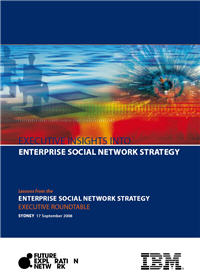In my blog post on financial transparency in start-ups a couple of days ago I referred to a blog post I wrote last year on how Path101 was becoming a ‘naked start-up’, blogging their Monday meetings and being fully open about their business. Nigel Burke pointed out in a comment that Path101 had soon discontinued this, and questioned how much of the supposed transparency was hype. Fair point.
I have put a comment on the Path101 blog to ask them about this – see below.
In short, certainly some of the shift to openness and transparency is rhetoric rather than reality (noteworthy being large companies that are nominally supporting initiatives such as dataportability but are in fact reluctant) . However there is still a very real ongoing trend to openness in business, including in start-ups. Balsamiq releasing its sales and Graham Dawson revealing his iPhone app revenue may be very small examples, but they are far from being alone in being willing to share. I absolutely believe that there are tangible advantages to what I call ‘strategic openness’, and this will be made clear by the leaders on this path.
Comment on Path 101 blog:
Hi guys,
I’m one of the people that blogged about Path101 as a ‘naked start-up’ back in October last year (https://bit.ly/aCeM).
I’d like to know, in what way are you a naked, transparent start-up now? Your blog is now just like any other start-up blog, sharing ideas and promoting yourself, but not giving any real insights into your journey as a company, or any details of your planning, fund-raising or anything else.
Blogging your Monday meetings was a very cool idea. So why did you stop doing that in December of last year?
Did you decide it was a bad idea, or did you just lose motivation to do it? I’m very interested to know.
There’s nothing wrong with being like other start-ups, but it is disappointing to see your early rhetoric of transparency and sharing what you’re learning on your entrepreneurial path quickly disappearing. Hopefully you’ll resume on your original transparent path, or if not others will take the lead on this, demonstrating to others why it creates value to be open.
[UPDATE 1:] Nigel Burke of Rusden who pointed out that rhetoric is not always matched by reality says that he has decided make his start-up naked, at: https://rusdensupdates.tumblr.com/. He says:
Following on from my comments on Ross Dawson’s blog I am moving to becoming more “naked”
I’m hoping to post my objectives, stats etc here at least once a week. I am also opening up my project hub where I keep my to-do’s and milestones; email projecthub@rusdens.com if you’re interested in a log-in.
The aim of this site is to produce feedback and develop relationships with potential peers, suppliers and customers.
Would love to know what you think – email nigel@rusdens.com with your comments
Fantastic.
[UPDATE 2:] Charlie from Path101 has responded to my comment and I’ve replied again.


